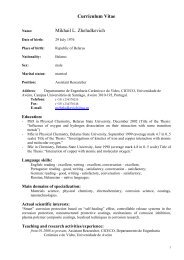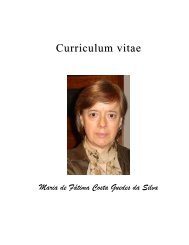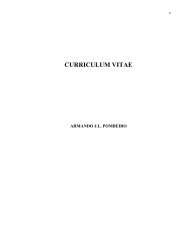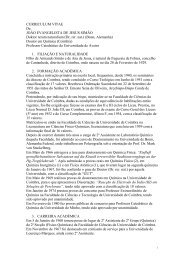XII Iberian Meeting of Electrochemistry XVI Meeting of the ...
XII Iberian Meeting of Electrochemistry XVI Meeting of the ...
XII Iberian Meeting of Electrochemistry XVI Meeting of the ...
Create successful ePaper yourself
Turn your PDF publications into a flip-book with our unique Google optimized e-Paper software.
<strong>XII</strong> <strong>Iberian</strong> <strong>Meeting</strong> <strong>of</strong> <strong>Electrochemistry</strong> & <strong>XVI</strong> <strong>Meeting</strong> <strong>of</strong> <strong>the</strong> Portuguese Electrochemical Society PD 08<br />
Gold Electrodeposition from Ionic Liquids:<br />
an Alternative to Conventional Aqueous Baths<br />
A.I.de Sá 1 , C.M. Rangel 1,2 , S. Quaresma 2 , S. Eugénio 2 , R. Vilar 2<br />
1 Laboratório Nacional de Energia e Geologia, Paço do Lumiar 22,<br />
Unidade de Pilhas de Combustível e Hidrogénio 1649-038 Lisboa, Portugal<br />
2<br />
Departamento de Materiais, Instituto Superior Técnico,<br />
Universidade Técnica de Lisboa, Av. Rovisco Pais, 1049-001 Lisboa, Portugal<br />
carmen.rangel@ineti.pt<br />
Ionic liquids have been proven to be suitable as electrolytes for <strong>the</strong> electrodeposition <strong>of</strong><br />
different metals as well as semiconductors materials [1]. In this work, an alternative bath<br />
for gold electroplating based on 1-butyl-1-methylpyrrolidinium dicyanamide (BMP-<br />
DCA) is proposed. The selection was based on <strong>the</strong> physical and chemical properties <strong>of</strong><br />
<strong>the</strong> ionic liquid, including its viscosity, conductivity and strong complexing capability<br />
[2]. The bath was prepared by adding HAuCl 4 .3H 2 O to <strong>the</strong> as received-ionic liquid,<br />
experiments were performed under laboratory atmospheric conditions. The water uptake<br />
<strong>of</strong> <strong>the</strong> ionic liquid was followed by Karl-Fischer titration and its effect on<br />
conductivity and on <strong>the</strong> electrochemical pr<strong>of</strong>ile was evaluated. Cyclic voltammograms<br />
were recorded using glassy carbon (see figure 1), nickel and copper as electrodes in<br />
order to characterize <strong>the</strong> gold reduction processes on <strong>the</strong> different substrates. Results<br />
suggested a two step reduction, under diffusion control. Nanocrystalline gold thin films<br />
were obtainable under potentiostatic control (-1 V, 1500 s) on copper and nickel<br />
electrodes at temperatures from 20 to 80ºC. The influence <strong>of</strong> temperature on <strong>the</strong> kinetics<br />
and morphology <strong>of</strong> gold deposits will be discussed. Characterization <strong>of</strong> <strong>the</strong> deposits was<br />
performed by XRD, SEM and TEM.<br />
i mA cm -2<br />
8.0E-04<br />
E / V<br />
-1.6 1<br />
-6.0E-04<br />
Fig. 1 Typical cyclic voltammogram (100 mVs -1 ) obtained on glassy carbon in 0.020 M<br />
HAuCl 4 .3H 2 O + BMP-DCA at 298 K.<br />
Acknowledgements<br />
This work was financed by Fundação para a Ciência e Tecnologia (F CT), under contract nº<br />
PTDM/ CTM/68847/2006. S. Quaresma and S. Eugénio also acknowledge F CT for <strong>the</strong> provision <strong>of</strong><br />
grants.<br />
References<br />
[1] Abedin S.Z.E, and Endres F., Chemphyschem, 2006, 7, 58<br />
[2] Deng M-J, Chen P-Y, Leong T-I, Sun I-W, Chang J-K and Tsai W-T, Electrochem. Commun.,<br />
2008, 10, 213.<br />
September, 811, 2010. ISEL - Lisbon 90








